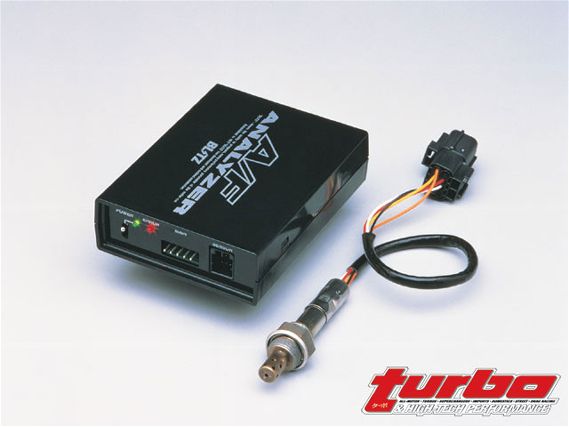 | How Much Is Your Engine Worth?
| How Much Is Your Engine Worth?
They say "money makes the world go 'round." Which is so true when it comes to racing. As your appetite for speed increases, your bank account correspondingly decreases. Every competitor will agree that drag racing is not a cheap thrill, building a race car can easily put you in the poor house. Performance enthusiasts spend thousands of dollars trying to get their vehicles down the track in record time. A fully-built turbocharged engine alone can cost as much as $10,000. And unlike car manufacturers, this high-performance powerplant does not come with a five-year, 50,000-mile warranty. Since none of us have a money tree growing in the backyard, protecting our investment should be of prime concern. To some degree, racers invest some money in gauges to monitor engine vitals. Oil pressure, water temperature, tach, boost pressure, exhaust gas temperature (EGT) etc. to name a few of the more widely used gauges. Yet, the most important vital signal of all usually gets ignored-the air/fuel ratio. Some might contest an exhaust temperature gauge gives you an idea whether the engine is running rich or lean from the temperature of the exhaust, which is true. However, the accuracy of measuring air/fuel ratio with an EGT gauge is almost as accurate as measuring the weight of a connecting rod for balancing purposes on the bathroom scale. Lean air/fuel mixtures can occur from a faulty fuel pump, clogged fuel lines, bad injectors, poor programming, etc. Running a lean air/fuel mixture under a full load can destroy an engine within seconds, depending on the severity of the lean mixture. Lean mixtures can destroy pistons, connecting rods, valves, block sleeves, combustion chambers, etc. totaling to hundreds probably thousands of dollars, not to mention the time and effort of a rebuild.
Today a number of companies are marketing monitoring devices to monitor air/fuel ratios. Some cost $100 while others cost as much as $5000. Most $100 units utilize the factory oxygen sensor to monitor the air/fuel ratio. Relying on one of these meters to monitor air/fuel ratios on your $10,000 engine is not too great of an idea. The stock computer monitors air/fuel ratios through voltage readings from the oxygen sensor. Stock oxygen sensors have a very narrow band of voltage reading, which is not ideal to use as a sensor for the air/fuel monitor. An air/fuel monitor is only as accurate as the oxygen sensor used. For optimum air/fuel readings a wide-band oxygen sensor has to be utilized. Unfortunately, due to the exclusivity of wide-band O2 sensors they have been known to cost a pretty penny or two. Unlike O2 sensors found in production vehicles, wide-band units are capable of reading a more accurate and broader voltage output from the sensor. Air/fuel monitoring devices that utilize a wide-band O2 sensor like the Motec meter can easily run upwards of $3000.
Blitz USA of Anaheim, California has noticed the need for an affordable and accurate air/fuel monitoring meter for the serious performance enthusiast. Blitz's A/F Analyzer ranks among the best in air/fuel meters yet with an affordable price tag. Each A/F Analyzer comes with a fast microprocessor box and its own heated wide-band O2 sensor for unparalleled performance. The five-wire wide-band O2 sensor offers a very wide range voltage readings which gives it greater resolution compared to stockers. This enables the unit to more accurately monitor air/fuel ratios from 10.0/1 to 16.0/1. The A/F Analyzer air/fuel readout is displayed on Blitz's Full Auto Turbo Timer (FATT) LCD screen. A warning mode is also incorporated into the unit to alert for lean conditions. The user is able of preset the air/fuel ratio that will trigger the warning alarm. An audible beep will sound off and the LCD display will turn from green to red warning the tuner or driver of the unsafe air/fuel ratio. Considering most racers are keeping their eyes on the track the sound will immediately signal the driver to let off the gas pedal preventing the engine from blowing up. Blitz's FATT meter can also be used as a turbo timer and voltage display meter. The FATT meter automatically calculates and adjusts the time needed to properly cool down the turbo. Battery voltage warning for high and low voltage is also incorporated into the unit. The user sets high and low warning modes to signal a voltage spike or excessive draw.
It's hard to over emphasize the importance of a good air/fuel meter, especially when it comes to tuning high-performance pressurized powerplants. Not only will running a safe air/fuel ratio save the engine but also increase horsepower by ensuring the mixture is burned efficiently, releasing the maximum amount of power. There is only one way to prevent a lean mixture from destroying your powerplant and that is constant monitoring of the air/fuel ratio. Blitz offers the chance to purchase some high-tech insurance for that high-dollar powerplant. So the question remains "how much is your engine worth?"
